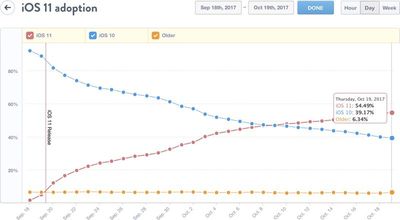iOS 11 Installed on Almost 55% of Devices One Month After Launch
One month after its official public release, iOS 11 has been installed on 54.49 percent of devices, according to data collected by analytics company Mixpanel.
iOS 11 was first released on September 19, and while adoption has been rather slow compared to iOS 10 adoption, it is steadily picking up. At the one week mark, iOS 11 was installed on 25 percent of devices, and at two weeks, installation climbed to 38.5 percent of devices.

At three weeks, iOS 11 adoption reached 47 percent, successfully overtaking iOS 10, and the gap between the two operating systems has continued to widen. With iOS 11 on nearly 55 percent of devices, iOS 10 is now installed on just 39.17 percent of devices. 6.34 percent of devices continue to run an older version of iOS.
Apple has released three minor updates to iOS 11 so far to address bugs and issues discovered since the launch of the new operating system. The most recent update, iOS 11.0.3, fixed an issue with haptic feedback and unresponsive displays, while iOS 11.0.2 addressed an irritating problem that caused the iPhone 8 and 8 Plus earpiece to crackle on phone calls.
iOS 11 adoption is likely to increase significantly when iOS 11.1 is released, if past iOS launches are any indication. Major .1 releases often spur people to update, and iOS 11.1 introduces new emojis and may include Apple Pay Cash, Apple's peer-to-peer Apple Pay feature. In past years, new emoji have had a noticeable impact on upgrade rates.
The iOS 11.1 update also fixes some lingering bugs, including one that caused Reachability to work improperly, and it addresses a serious WPA2 Wi-Fi vulnerability. It's not yet clear when Apple plans to release iOS 11.1, but there have been three betas thus far.
Popular Stories
Despite being more than two years old, Apple's AirPods Pro 2 still dominate the premium wireless‑earbud space, thanks to a potent mix of top‑tier audio, class‑leading noise cancellation, and Apple's habit of delivering major new features through software updates. With AirPods Pro 3 widely expected to arrive in 2025, prospective buyers now face a familiar dilemma: snap up the proven...
Apple plans to release an all-new super thin iPhone this year, debuting it alongside the iPhone 17, iPhone 17 Pro, and iPhone 17 Pro Max. We've seen pictures of dummy models, cases, and renders with the design, but Lewis Hilsenteger of Unbox Therapy today showed off newer dummy models that give us a better idea of just how thin the "iPhone 17 Air" will be.
The iPhone 17 Air is expected to be ...
A developer has demonstrated Windows 11 ARM running on an M2 iPad Air using emulation, which has become much easier since the EU's Digital Markets Act (DMA) regulations came into effect.
As spotted by Windows Latest, NTDev shared an instance of the emulation on social media and posted a video on YouTube (embedded below) demonstrating it in action. The achievement relies on new EU regulatory...
Apple's iPhone development roadmap runs several years into the future and the company is continually working with suppliers on several successive iPhone models simultaneously, which is why we often get rumored features months ahead of launch. The iPhone 17 series is no different, and we already have a good idea of what to expect from Apple's 2025 smartphone lineup.
If you skipped the iPhone...
Apple seeded the third beta of iOS 18.5 to developers today, and so far the software update includes only a few minor changes.
The changes are in the Mail and Settings apps.
In the Mail app, you can now easily turn off contact photos directly within the app, by tapping on the circle with three dots in the top-right corner.
In the Settings app, AppleCare+ coverage information is more...
Apple will unveil the iPhone 17 Pro in a new Sky Blue color, the same color that debuted on the latest M4 MacBook Air models Apple released in March. That's according to the leaker Majin Bu.
Concept mockup from Majin Bu
Writing on his website, Bu claims that "sources close to the supply chain confirm that several iPhone 17 Pro prototypes have been made in various colors, with Sky Blue...
While the iPhone 17 Pro and iPhone 17 Pro Max are not expected to launch until September, there are already plenty of rumors about the devices.
Subscribe to the MacRumors YouTube channel for more videos.
Below, we recap key changes rumored for the iPhone 17 Pro models as of April 2025:
Aluminum frame: iPhone 17 Pro models are rumored to have an aluminum frame, whereas the iPhone 15 Pro and ...























